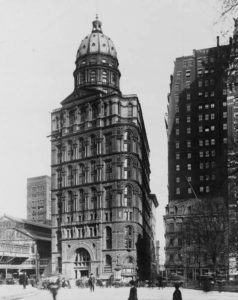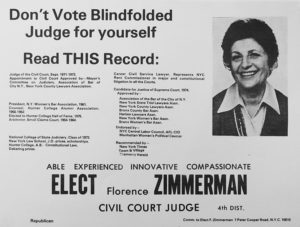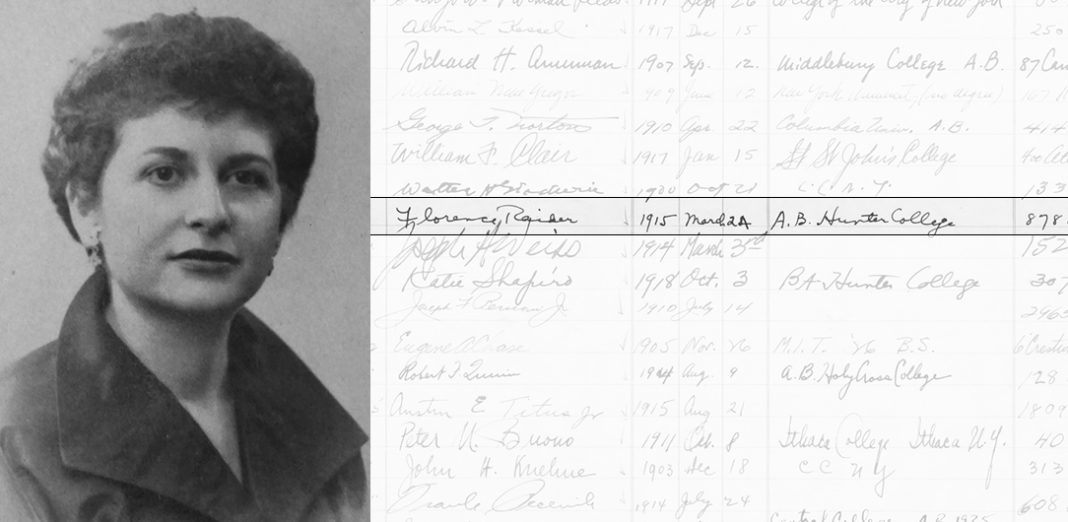Retired Judge Florence Zimmerman ’41 made headlines in April 2018 when, at age 103, she attended her Hunter College alumni reunion. It wasn’t her first time in the spotlight. For much of her life, Judge Zimmerman has received accolades and attention. As one of the first 12 women to graduate from NYLS, the Law School’s oldest-living alum, and an accomplished former city employee and judge, she’s had an extraordinary life. Today, she lives in Riverdale, where she recently shared her experiences as a pioneering female lawyer with New York Law School Magazine.
Born in Scranton, Pennsylvania in 1915, Judge Zimmerman was the middle child of Polish-Russian immigrants who worked in the restaurant business.
“My parents were very proud of their children,” Judge Zimmerman recalled. “They said, ‘Study, and you’ll do well. So, we studied hard, and we did well.”
By the time Judge Zimmerman was a teenager, her family had moved to New York City, where she was beginning to make her mark on the city’s civic life. In 1933, as a graduating senior at James Madison High School in Brooklyn, Judge Zimmerman was one of 228 high school students throughout the city, and one of just eight from her high school, to receive a “Cooperation-in-Government” award from the Civic Cooperation League. According to a June 25, 1933 New York Times article on the winners, the award was given for “straight thinking backed by caution, courage and confidence.”
Four years later, Judge Zimmerman’s name was in the paper again. This time, she was listed as one of 830 graduates of Hunter College, earning both a degree in Economics and a Constitutional Law Prize, as reported by the Times on June 16, 1937. Her graduation from Hunter College was held at Carnegie Hall, the same site as NYLS’s Commencement ceremony in 2018 and many prior years.
On June 18, 1937, Judge Zimmerman was once more mentioned in the Times when, at age 23, she became one of just 16 college students selected by Mayor Fiorello H. La Guardia to receive a summer internship at a city agency. She and the other college interns were recognized in a ceremony at City Hall. A few weeks later, the paper highlighted her internship assignment with Deputy License Commissioner Dorothy Kenyon. That story, dated July 2, 1937, also noted Judge Zimmerman’s plans to attend law school. Kenyon, a lifelong political civil liberties and women’s rights icon who would later become a municipal judge, provided Judge Zimmerman with a rare example of a woman in a civic leadership position.
 Pursuing a Law Degree
Pursuing a Law Degree
The fall after her city government internship, Judge Zimmerman enrolled at NYLS. At the time, the School was in the former Pulitzer Building at 63 Park Row, where it had relocated in 1936. Just a few months before Judge Zimmerman began her legal studies, NYLS’s first female graduate, Elizabeth Johnston Schenkel, had completed hers.
“NYLS was very good to me,” Judge Zimmerman said, noting that an academic scholarship made law school possible financially.
Judge Zimmerman was an evening student. By day, she prepared documents in a legal office, having taught herself how to write shorthand and how to type. Balancing work and law school meant long days. She recalled scrambling to eat a sandwich in transit from her office to class. After class, she headed home to her family (then living in the Bronx) around 10:00 or 11:00 p.m. Judge Zimmerman said that sometimes she went to bed as late as 4:00 a.m. before getting up for work a few hours later.
“If you want to be a professional, you have to work hard,” she said. “I was the first in my family to be a professional woman. They were very proud of that. We pushed one another up and up.”
When she graduated from NYLS in 1941, one of two women in her class, Judge Zimmerman again made headlines as one of seven students to receive “special prizes” according to a June 12, 1941 New York Times story about NYLS’s graduation ceremony. (The School discontinued operations in June 1941, due to World War II. It would reopen six years later.)
Not long after her graduation from NYLS, Judge Zimmerman was back in the paper. That August, she was listed in the Times as one of the 690 June graduates who passed the bar. The bar pass mention made her family “very proud,” she said.
In October 1946, Judge Zimmerman, then age 31, married her husband Henry Zimmerman, also a lawyer. The two met through their families and were married for 35 years until his death in 1981. After their marriage, Judge Zimmerman continued to include her maiden name, Raider, along with Zimmerman professionally. The couple settled in Peter Cooper Village, where they were among the original tenants of the large, post-World War II housing development. Judge Zimmerman would reside there for the next 66 years.
Building a Career in Public Service
Judge Zimmerman spent the bulk of her career as a city attorney specializing in rent regulation. She represented New York City agencies that oversaw rent regulation and the New York City Rent Commissioner in litigation. The work was complex and, during the 1950s and 1960s, rent control laws changed “many, many times,” Judge Zimmerman recalled. (The names of the government agencies that oversaw it also changed.)
She worked closely with Hortense Gabel, who in 1962 was appointed New York City Rent and Rehabilitation Commissioner by Mayor Robert F. Wagner Jr. (the son of distinguished NYLS Class of 1900 graduate Robert F. Wagner Sr.). Gabel, another example of a woman in a commanding role, would also later go on to become a judge. A 1962 New York Times profile dubbed Gabel the “Lady Against the Slums” for her efforts to raise living standards for low-income tenants while treating landlords fairly.
On June 7, 1963, Judge Zimmerman once again saw her name in ink—this time, for having argued the city’s position before the New York Court of Appeals in a precedent-setting rent control case. The case involved whether a group of establishments that called themselves “hotels” were subject to state and city rent control laws. The city maintained that the establishments in question were boarding houses that masqueraded as hotels and therefore were subject to rent control, and the Times story paraphrased from Judge Zimmerman’s oral arguments. In July 1963, the Court of Appeals ruled in the city’s favor.
Outside of city government, Judge Zimmerman was a Small Claims Court arbitrator from 1954 to 1964 and a leader in the legal community. In 1961 and 1962, she served as President of the New York Women’s Bar Association. She was also a member of the New York County Lawyers Association and the American Bar Association and active in the Hunter College Alumni Association.
She said she looked for ways to mentor other professional women: “They probably had as hard a time getting there as I did.”
Joining the Judiciary
In 1971, Mayor John Lindsay appointed Judge Zimmerman to the New York City Civil Court. Her appointment was approved by the Mayor’s Committee on the Judiciary, the New York City Bar Association, and the New York County Lawyers Association. Mayor Lindsay hand-wrote a note of congratulations on a photo of her swearing-in, signing it “from an old friend.” He subsequently reappointed her to the court, as reported in the Times on December 29, 1972.
Recalling her experience as a judge, she said, “When a case comes before you … you have to be 100 percent right on the law. You’re the lawyer for the court. When you talk to the client, you have to know what you’re talking about. If you don’t, they won’t respect you.” Asked which of her cases was the most important, she said, “the case that was before me” at the given moment.
 In 1974, Judge Zimmerman ran for a New York Supreme Court seat. Her marketing materials billed her as “An Outstanding and Capable Judge Who Served on the Civil Court.” Her candidacy was approved by numerous groups, including the New York City Bar Association, the New York State Trial Lawyers Association, the Harlem Lawyers Association, and the Bronx Women’s Bar Association, and she was endorsed by the AFL-CIO, the Manhattan Women’s Political Caucus, The New York Times, the Gramercy Herald, and Town & Village. Still, running on the Republican ticket in Democrat-dominated New York City proved too high of an obstacle, and Judge Zimmerman was not elected. She returned to civil service legal work, where she continued to represent the city in significant rent-control cases. In 1975, she was listed in Hunter College’s “Hall of Fame” for her professional accomplishments.
In 1974, Judge Zimmerman ran for a New York Supreme Court seat. Her marketing materials billed her as “An Outstanding and Capable Judge Who Served on the Civil Court.” Her candidacy was approved by numerous groups, including the New York City Bar Association, the New York State Trial Lawyers Association, the Harlem Lawyers Association, and the Bronx Women’s Bar Association, and she was endorsed by the AFL-CIO, the Manhattan Women’s Political Caucus, The New York Times, the Gramercy Herald, and Town & Village. Still, running on the Republican ticket in Democrat-dominated New York City proved too high of an obstacle, and Judge Zimmerman was not elected. She returned to civil service legal work, where she continued to represent the city in significant rent-control cases. In 1975, she was listed in Hunter College’s “Hall of Fame” for her professional accomplishments.
Judge Zimmerman was long retired when, in 2013, she moved from her home in Peter Cooper Village to Riverdale, not far from her niece, Judy Oshry. Two years later, Judge Zimmerman received a signed letter from then-President Barack Obama congratulating her on her centennial birthday.
Reflecting on a Remarkable Career
In March 2018, Judge Zimmerman turned 103, and Marcey L. Grigsby ’06, Vice President of Institutional Advancement at NYLS, attended her birthday party in Riverdale. She gave Judge Zimmerman a signed letter from Dean Crowell, wishing her a happy birthday and congratulating her on her many career accomplishments.
The letter noted that NYLS’s 2017 entering class was 60-percent female—a dramatic change from 1941. “The women who attend New York Law School today follow in your footsteps,” it said. “And the path you have laid is nothing short of remarkable.”
Reflecting on how the legal profession has changed for women, Judge Zimmerman observed, “Women today want to be professionals. They get in on a scholarship. They want to be there, and so they work hard. The progress women have made is very wonderful.”
At the end of her interview with New York Law School Magazine, she had a message for readers of her latest headline: “I’m modest, and I feel honored that you asked me to tell you about my experiences. It’s very flattering.”
Editor’s Note: New York Law School Magazine thanks the staff of Atria Senior Living in Riverdale, especially Executive Director Rena Hyman and Life Guidance Director Frankie Diaz, for generously facilitating this interview. We are also deeply grateful to Judge Zimmerman’s niece, Judy Oshry, for providing the photos and documents associated with this story and for sharing details of Judge Zimmerman’s extraordinary life.


